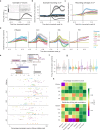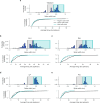Reproducibility of in vivo electrophysiological measurements in mice
- PMID: 40354112
- PMCID: PMC12068871
- DOI: 10.7554/eLife.100840
Reproducibility of in vivo electrophysiological measurements in mice
Abstract
Understanding brain function relies on the collective work of many labs generating reproducible results. However, reproducibility has not been systematically assessed within the context of electrophysiological recordings during cognitive behaviors. To address this, we formed a multi-lab collaboration using a shared, open-source behavioral task and experimental apparatus. Experimenters in 10 laboratories repeatedly targeted Neuropixels probes to the same location (spanning secondary visual areas, hippocampus, and thalamus) in mice making decisions; this generated a total of 121 experimental replicates, a unique dataset for evaluating reproducibility of electrophysiology experiments. Despite standardizing both behavioral and electrophysiological procedures, some experimental outcomes were highly variable. A closer analysis uncovered that variability in electrode targeting hindered reproducibility, as did the limited statistical power of some routinely used electrophysiological analyses, such as single-neuron tests of modulation by individual task parameters. Reproducibility was enhanced by histological and electrophysiological quality-control criteria. Our observations suggest that data from systems neuroscience is vulnerable to a lack of reproducibility, but that across-lab standardization, including metrics we propose, can serve to mitigate this.
Keywords: decision-making; electrophsyiology; mouse; neuropixels; neuroscience; open science; reproducibility; vision.
© 2024, International Brain Laboratory et al.
Conflict of interest statement
KB, JB, JB, DB, DB, NB, SB, KB, RC, MC, AC, MD, HL, MF, BG, FH, JH, CH, AK, CK, PL, CL, NM, GM, NM, JN, LP, AP, CR, NR, MS, KS, NS, KS, MT, AU, SW, MW, SW, MW, OW, IW, YZ No competing interests declared, GC receives an honorarium from the Simons Foundation as part of her role as a member of the scientific advisory committee, ZM Reviewing editor, eLife
Figures
































Update of
- doi: 10.1101/2022.05.09.491042
- doi: 10.7554/eLife.100840.1
- doi: 10.7554/eLife.100840.2
References
-
- Aguillon-Rodriguez V, Angelaki D, Bayer H, Bonacchi N, Carandini M, Cazettes F, Chapuis G, Churchland AK, Dan Y, Dewitt E, Faulkner M, Forrest H, Haetzel L, Häusser M, Hofer SB, Hu F, Khanal A, Krasniak C, Laranjeira I, Mainen ZF, Meijer G, Miska NJ, Mrsic-Flogel TD, Murakami M, Noel J-P, Pan-Vazquez A, Rossant C, Sanders J, Socha K, Terry R, Urai AE, Vergara H, Wells M, Wilson CJ, Witten IB, Wool LE, Zador AM, International Brain Laboratory Standardized and reproducible measurement of decision-making in mice. eLife. 2021;10:e63711. doi: 10.7554/eLife.63711. - DOI - PMC - PubMed
-
- Banga K, Boussard J, Chapuis G. Spike sorting pipeline for the international brain laboratory. Figshare. 2022 doi: 10.6084/m9.figshare.19705522.v3. - DOI
MeSH terms
Grants and funding
LinkOut - more resources
Full Text Sources
Miscellaneous

